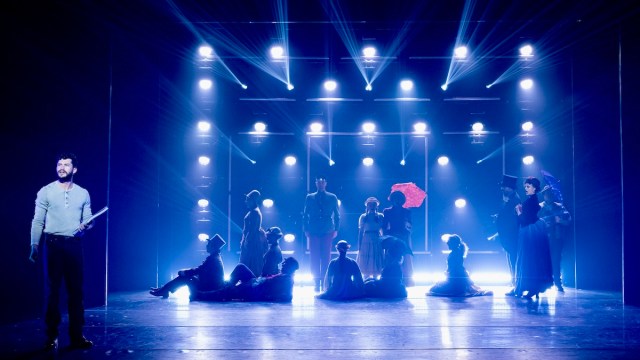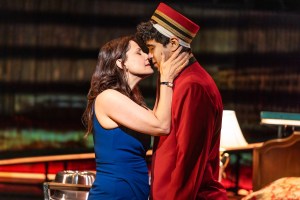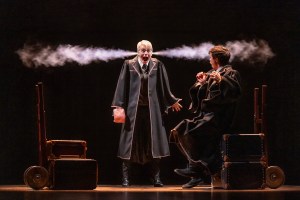Review: A Fresh Sunday in the Park With George Brims With Color and Light in New Jersey
Eamon Foley’s imaginative production of the Sondheim-Lapine musical runs at the Axelrod Performing Arts Center.

(© Micheal Hull)
Georges Seurat never sold a painting in his lifetime. Today, his magnum opus A Sunday Afternoon on the Island of La Grande Jatte hangs on permanent display in the Art Institute of Chicago, drawing spectators from across the globe. Sometimes it takes a generation or two to truly appreciate a unique point of view. Stephen Sondheim and James Lapine immortalized Seurat’s revolutionary perspective in Sunday in the Park With George, perhaps musical theater’s greatest statement on “the art of making art.” Forty years after its premiere, director Eamon Foley offers a fresh and captivating new vision of this work at the Axelrod Performing Arts Center in Deal, New Jersey.
Sondheim and Lapine looked at Seurat’s massive canvas, composed entirely of tiny color flecks that arrange themselves into images in the viewer’s eye, and built an entire world. The first act chronicles the painting creation, as George (Graham Phillips) quarrels with his model and muse, Dot (Talia Suskauer), and takes on the chin the snide rejection of his more successful contemporaries. The second act, set a century later, deals with legacy, as Seurat’s grandson — also named George and also played by Phillips — questions his own artistic vision amid mounting success.
The musical presents Seurat as a man overwhelmed by a new way of seeing that only he can fully comprehend. Foley — artistic director of Grind Arts Company, a co-sponsor of this production — manifests this in the form of six ballet dancers, each costumed in a differently colored leotard, who emerge as if from George’s brain to aid in his painting. (The costumes are by DW.) Rather than seeming gimmicky or distracting, the dancers make plain what is often so hard to grasp: the almost fanatical bursts of creativity that overwhelm an artist when on a mission to make something new. In the second act, the dancers, all members of the Axelrod Contemporary Ballet Theater, return as avatars of the new George, drolly commenting on the vapid cocktail culture of the 1980s.
Like the work of the subject itself, the production succeeds because it embraces a wholly singular aesthetic. Foley’s Sunday looks like no other staging I’ve ever seen. Ryan Howell’s scenic design is striking in its austerity, representing both Parisian parks and American art galleries with a few tasteful benches and ladders. Projection designer Brad Peterson playfully distorts Seurat’s images, filling the white scrim that dominates the back wall — the “blank page of canvas” that George so loves — with infinite possibilities.
The true triumph, though, is Paul Miller’s brilliant lighting, which continually invites the audience, as Seurat once did, to reconsider how it views what seems so obvious in front of them. If this production were mounted on Broadway, the second act unveiling of George’s Chromolume alone would guarantee a Tony nom.

(© Micheal Hull)
Phillips presents a refreshingly youthful George, capturing not only his callousness and temperament but his single-minded passion. He sings with focus and innate musicality, and he generates palpable chemistry with Suskauer’s Dot. I’m not sure I’ve ever understood the combustible yet tender dynamics of their relationship more than I do here, and it makes their eventual parting seem all the more tragic. Suskauer’s Dot is wry and self-possessed, and she’s heartbreakingly sincere when she returns in the second act as George’s grandmother Marie, who encourages her grandson to live a rich and full life, not just one of the mind. With vocal cords of steel, Suskauer sings Sondheim’s long and difficult score without ever flagging.
Fine performances abound in the supporting company: Bernard Dotson’s imperious Jules; Katie Davis’s haughty Yvonne; Giuliana Augello and Bridget Gooley’s bubbly pair of Celestes; Anthony Cataldo’s caddish soldier. Joy Hermalyn has moving moments as the Old Lady in the first act and the art critic Blair in the second, though she occasionally adds an exclamation point to lines that don’t need it. An 11-piece band conducted by Jacob Hayes manages Sondheim’s complex music with subtlety and verve.
When Dot appears before the contemporary George in the musical’s final moment, she provides him with a piece of valuable advice: “Give us more to see.” By taking a modern classic and revitalizing it in ways that feel entirely fresh and original, Foley and his talented stable of designers and performers have done exactly that.









